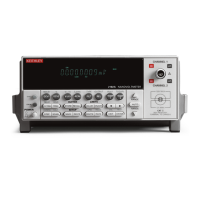SCPI Signal Oriented Measurement Commands 13-3
• Buffer operation is disabled. A storage operation presently in process will be aborted.
• Autozero is set to the *RST default value.
• All operations associated with stepping or scanning are disabled.
This command is automatically asserted when the :MEASure? command is sent.
Program fragment
CALL SEND (7, “:conf:volt”, status%) ‘ Perform CONFigure operations.
CALL SEND (7, “:trig:del 0.5”, status%) ‘ Set delay for 0.5sec.
CALL SEND (7, “:samp:coun 10”, status%) ‘ Set sample count to 10.
CALL SEND (7, “:read?”, status%) ‘ Trigger and request readings.
reading$ = SPACE$(80)
CALL ENTER(reading$, length%, 7, status%) ‘ Address 2182 to talk.
PRINT reading$ ‘ Display the 10 readings on the
‘ CRT.
:FETCh?
Description
This command requests the latest post-processed reading. After sending this command and
addressing the Model 2182 to talk, the reading is sent to the computer. This command does not
affect the instrument setup.
This command does not trigger a measurement. The command simply requests the last
available reading. Note that this command can repeatedly return the same reading. Until there is
a new reading, this command continues to return the old reading. If your application requires a
“fresh” reading, use the :DATA:FRESh? command (see the SENSe Subsystem command).
This command is automatically asserted when the :READ? or :MEASure? command is sent.
:READ?
Description
This command is typically used with the instrument in the “one-shot” measurement mode to
trigger and acquire a specified number of readings. The :SAMPle:COUNt command is used to
specify the number of readings (see Trigger Subsystem). Note that the readings are stored in the
buffer.
When this command is sent, the following commands execute in the order they are presented:
:ABORt
:INITiate
:FETCh?
When :ABORt is executed, the instrument goes into the idle state if continuous initiation is
disabled. If continuous initiation is enabled, the operation re-starts at the beginning of the
Trigger Model.

